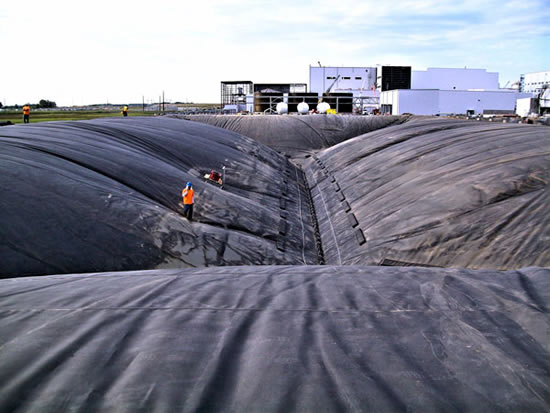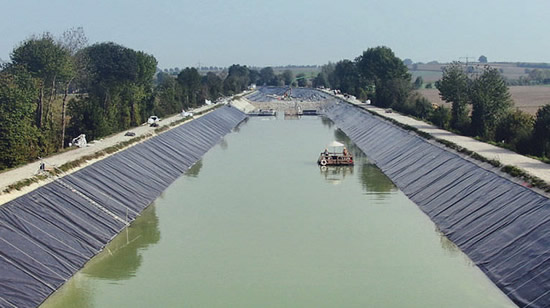During GeoAmericas 2016, Dr. Neil Dixon’s sustainability keynote touched upon many topics for the future of geosynthetics. While sustainability drove most of the lecture, a few of his ideas simply approached how the field positioned itself in the marketplace. He suggested, for example, moving the field away from isolating language like “versus traditional materials.”
With 40+ years of projects that document how and why geosynthetics have become indispensable to modern infrastructure, why do we continue to present geosynthetic solutions as alternatives?
When will we—the field—present geosynthetics as an equally accepted option in projects that also consider aggregates, clays, hard armor, inextensible reinforcement, thick soil layers, etc.?
In the end, geosynthetics are selected on the same sort of criteria as other engineered system materials. Chiefly: suitability, performance, and economy.
GEOSYNTHETICS VS TRADITIONAL MATERIALS
Dr. Dixon’s question is interesting. All options in a project, of course, are “alternatives.” But, he is right to point out that the suggestion may be that geosynthetics are, forever, “new.” This can be problematic.
A 2012 US Government Accountability Office (GAO) survey of state DOTs—a survey which included specific discussion of geosynthetics—concluded that “new technologies” can be a problem for agencies because they generally compel higher bonding costs, which are in turn passed to the states through the bids. This creates government-level resistance in spending.
On the other side of the ledger, geosynthetics have an advantage in being very well tested materials. They are tested at bench and index levels and in the field perhaps more so than any of the construction materials and system designs they might compete with. There are also many government-related data gathering programs that support geosynthetics (e.g., AASHTO NTPEP in the US, BAM in Germany, etc.).
In looking at the literature distributed by manufacturers of geosynthetics, we do find repeated uses of “versus traditional materials” or “versus conventional approaches.” We find it throughout industry publications too (including this one).
One manufacturer, for example, cast the term “traditional” 7 times in a 350-word flyer regarding an updated leachate collection system design.
Furthermore, the new wave of modifications to geosynthetic products has added a new wrinkle. Enhanced geosynthetics, such as electrically conductive liners or modified bentonite cores in GCLs, have been positioned as alternatives to “traditional liners” and “traditional GCLs.”
Geosynthetics, it seems, are now an alternative to traditional geosynthetics, which are an alternative to traditional materials.

GOING FORWARD
None of this is to suggest the field of geosynthetics really has a problem. It doesn’t. And, there are plenty of reasons one can argue for framing geosynthetics as an alternative to “traditional designs” or “conventional approaches” in engineering. The very absence of geosynthetics from so many college engineering programs is a great concern today, and a major reason why the International Geosynthetics Society (IGS) has relaunched the Educate the Educators program in the US, Brazil, China, etc.
And, it was just in May 2014 that the US Water Resources Reform and Development Act (WRRDA) passed with its historic mention of geosynthetics directly in its USD $12.3 billion conference report. The bill specifically mentioned geosynthetics within a section on durability and sustainability. Section 130, on “Resilient Construction and Use of Innovative Materials,” instructs the US Army Corps of Engineers to consider “durable, resilient, and sustainable materials and practices, including the use of geosynthetics, advanced composites, and innovative technologies” in carrying out its work.
The intriguing thing about the USACE language is that it frames geosynthetics not only as innovative—which in most contexts implies non-traditional—but as accepted solutions that must be considered. The language implores the practice of engineering to recognize geosynthetics as an equal option.
It will likely take years, but the practice of geosynthetics may shift its language ever so slightly. It won’t be a dramatic switch. It may simply be to explain the basic selection criteria by which a geosynthetic solution was specified—cost advantages, sustainability advantages, etc.—rather than for being a later-to-the-dance option. It will simply be a matter of not emphasizing that other options are older, because to do so may be to imply they are more commonly specified and accepted (rather than implying that geosynthetics deserve greater consideration).

With every case study and application note, how we wield this “traditional materials” language matters. It’s something for all of us to consider.












Indeed you make a great point